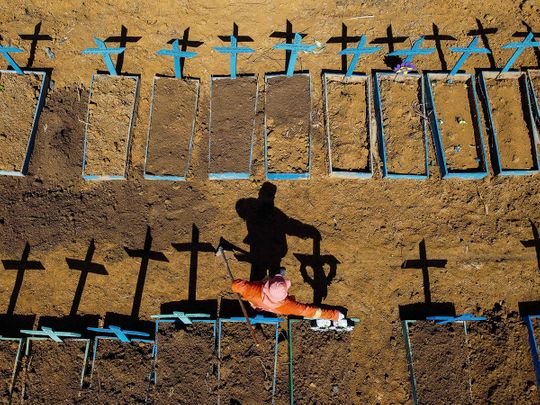
Santiago: South America moved to put the brakes on surging coronavirus cases Thursday, as Chile closed all its borders for the month of April, Bolivia shuttered its frontier with Brazil and Peru went into Easter lockdown.
Ecuador also announced a 30-day “state of exception” affecting over a third of its population, with a curfew in force for the next week.
Chile’s government said it would batten down the hatches starting next Monday while it seeks to speed up its vaccination campaign.
The measure came as the country recorded its highest daily infection rate since the pandemic began.
Chile has passed the mark of a million reported infections, with over 23,000 deaths recorded since March last year.
Intensive care units are close to capacity, and government spokesman Jaime Bellolio said Thursday: “We urgently need to make an additional effort, because we are in a very critical moment of the pandemic.”
New infections
Neighboring Peru entered a four-day national lockdown for the Easter weekend, as it too recorded its highest number of daily confirmed cases since the start of the pandemic with almost 13,000 new infections.
Peru’s average daily infection rate last week exceeded 9,000, with about 200 fatalities every 24 hours.
The streets of Lima were quiet with little other than food shops and pharmacies open, while restaurants were limited to take-aways and home deliveries.
Peruvians have lived under a daily curfew for the last 13 months, along with a ban on public gatherings, though this has not stopped politicians from amassing supporters for campaign events ahead of April 11 presidential elections.
In the early hours of Friday, Ecuadorian president Lenin Moreno announced on Twitter he had signed a decree bringing a “state of exception” into force.
The text of the decree called the current virus situation a “public calamity”, warning that different age groups had been affected and that there were new symptoms and fresh strains of Covid-19 in the country.
In affected provinces, movement will be restricted for nine hours during the night, public gatherings are prohibited, and municipalities have agreed to close public beaches.
Ecuador was placed under a state of exception for much of 2020, from March to September, with curfews of up to 14 hours a day.
The country is also holding an election - the second round of its presidential poll - on April 11, and the decree mentioned “specific actions to guarantee this right.”
South America has been hard hit by the new pandemic wave, with Brazil at its epicenter, registering more than 66,000 deaths in March alone.
Peru has a ban in place until April 15 on all flights from Brazil, as well as Britain or South Africa, to try and prevent virus variants from those countries entering its territory.
On Thursday, Bolivia said it would completely close its border with Brazil for at least a week from Friday and place border towns where the Brazilian virus variant had been identified under lockdown.
Speed up
Bolivia has reported 12,257 coronavirus deaths out of more than 272,000 recorded infections so far, and hopes to vaccinate its adult population by September.
Chile is seeking to speed up its immunization drive, despite already being one of the best-performing countries in the world - seven million of its 19 million population have received at least one shot, and 24 percent have received the two doses required for immunity.
In Peru, with a population of 33 million, some 570,000 people have received a shot.
Ecuador has faced delays in rolling out its immunization program, and February saw its health minister resign over well-connected citizens jumping the queue for coronavirus vaccines.
Peru and Argentina, too, have been hit by outcries over the rich and powerful getting their coronavirus jabs out of turn.








